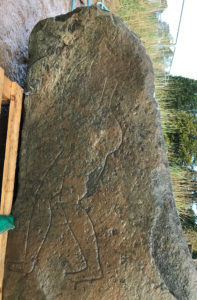Workmen on a £35 million road project made a surprise discovered when they uncovered a Pictish stone.
The team, working on Perth & Kinross Council’s A9/A85 project, recently uncovered a large carved stone whilst excavating part of the site.
Contractors Balfour Beatty stopped works in the area to allow archaeologists from Perth and Kinross Heritage Trust and Culture Perth & Kinross to inspect the stone and the site of its discovery.
The stone was identified by Mark Hall, of Perth Museum & Art Gallery, as displaying a particular kind of Pictish carving not previously known in the Perth and Kinross area. The carving is thought to be extremely significant as very few stones carved with this particular type of image have been found in Scotland and its discovery identifies the importance of the local area in Pictish times.

The Pictish carving found during the construction of the new road
Similar Pictish stones have been discovered in Aberdeenshire, the Highlands and Islands and Shetland. These all show single figures with grotesque faces and holding one or more weapons.
The new addition from Perth and Kinross shows a figure walking right to left, holding a spear in his right hand. The weapon is typical of spears of the mid first millennium AD. In his left hand he holds a club or a staff however this is unclear.
He appears to be wearing a cloak and shoes and has a very pronounced hair style, with a shaven front scalp. The figure’s face is obscured by wear to the stone but he seems to have had a large nose.
No Pictish archaeological sites are known in the immediate vicinity of where the new carving was found but the stone does suggest the presence of a powerful noble locally. The fearsome figure probably served to warn travellers and visitors that they were approaching his residence or territory.
The study of the carving and what it can reveal about life in Pictish Scotland will continue. The Scottish Treasure Trove has been notified and the carving will be allocated to a museum in due course.
After an inspection of the find spot, no further archaeological works were considered necessary and the roadworks have resumed.

Balfour Beatty workers who made the discovery discuss their find
The A9/A85 scheme is the first phase of the Perth Transport Futures Project which started on site in October 2016, and is due to be completed in March 2019.
Leader of Perth & Kinross Council, Councillor Ian Campbell said: ‘I am led to believe Pictish symbol stones come in many shapes and sizes, and date broadly to the sixth-eighth centuries AD.
‘I understand very little is known about the purpose of Pictish stones and the real meaning of the symbols they carry. In terms of their function, theories include their serving as grave markers or memorials to Pictish nobles, or their standing as territorial markers.
‘I look forward to hearing what the experts conclude from their examination of this clearly fascinating stone.’
David Strachan of Perth and Kinross Heritage Trust added: ‘I would like to take this opportunity to thank the finders of the carving for drawing it to our attention.
‘This is a really significant find as there are very few such stones known in Scotland, it’s a signal of the importance of the area in Pictish times.’
TAGS

